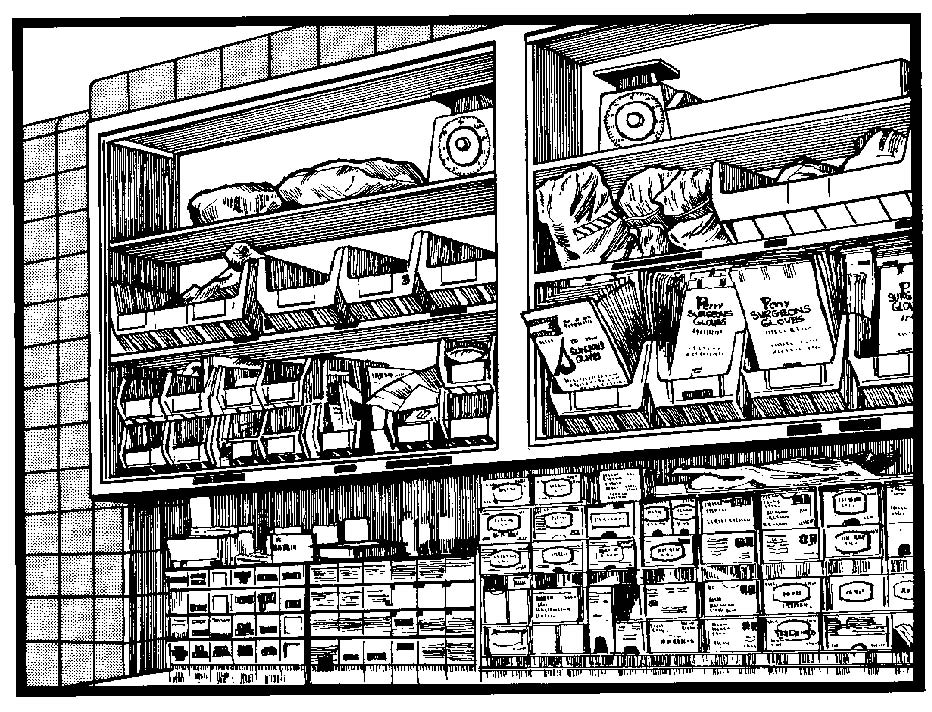Introduction to the Operating Room
LESSON 1: ORIENTATION
1-7
1-7. CONSTRUCTION
a. Discussion. Construction of the individual ORs is important because each room should provide an ideal area for the performance of surgery. In addition, proper construction makes provision for the maximum efficiency of personnel and for the safety of both patients and OR personnel. Proper construction and size are also related directly to ease of cleaning and the maintenance of aseptic technique.
b. Floors. Floors should be smooth, wear-resistant, and nonporous. Suitable materials include ceramic tile, terrazzo, or vinyl plastic approved for installation in the OR by the National Fire Protection Association. Edges and corners at the juncture of floor and walls are rounded to prevent the accumulation of dust and facilitate cleaning. The ceramic tile or other material used for construction of floors is impregnated with a conductive material and is rounded. The purpose of this type of flooring is to provide a path, which will conduct electricity away from all persons and equipment making contact with the floor, thus preventing the accumulation of dangerous electrostatic charges. Conductive flooring for special application rooms is not required where inflammable anesthetic gases are prohibited and where a high degree of monitoring is required.
c. Walls. Walls no longer have to be tiled. The plaster between the tiles is porous and can harbor bacteria. New paneling materials and flexible wall coverings, along with new adhesives, permit completely sealed wall, ceiling, and floor joints so that these surfaces may be washed with all types of bactericidal chemical solutions. However, the walls may be covered completely with nonglare tile. If tiled, the tile should reach at least six feet up from the floor for easy wet-cleaning and scrubbing. The upper portions of the walls are painted with a washable pastel paint the color of the tile.
d. Ceilings. Ceilings are often smooth, washable, and soundproofed. They are often painted the same or similar color as the walls. White is no longer used since colors lessen the glaring reflection of light in the eyes.
e. Cabinets. Cabinet can be provided for the storage of sutures, medications, infusion sets, and other supplies. If recessed into the walls and provided with sliding doors, these cabinets conserve working space and interfere less with the maintenance of aseptic technique. Cabinets should be in a well-lighted area of the room and should be easily accessible to the circulator who will be required to furnish supplies from them during the operative procedure (see figure 1-4).
Figure 1-4. Cabinet in an operating room.
f. Doors. Doors may be of several types. All doorframes should be a minimum of five feet in width. One type of door is the "double acting" (swinging) type with rubberized door guards on each side. These doors should be equipped with a window for easy visualization from both sides (see figure 1-5). A second type is a door, which swings outward. Swinging doors produce air turbulence, which increases bacteria count. However, minimum use of swinging doors is advised
Figure 1-5. Swinging doors.
g. Signal Light. Each room should be equipped with an emergency signal light or call button that can be operated conveniently by the anesthetist or circulator.
NOTE: In this subcourse, references to the "scrub" and "circulator" pertain to certain
duties performed by the OR specialist. (Refer to lesson 2, paragraph 2-18.)
h. Special Surgical Needs. The Surgical Specialties require consideration of special needs. For example, flush-mounted snap-lock water connections for the heart-lung machine, X-ray facilities, space for neurocryosurgery, and special outlets for air-powered equipment may be required. Some Specialties use fiber optics, a laser apparatus, special built-in television, or cine cameras. Each service is consulted for any anticipated special needs that will require preparation, operation, or maintenance by the nursing service.



